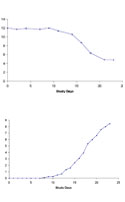Cognitive impairment is common in multiple sclerosis (MS), occuring at all stages of disease. It is a main source of disability, social impairment and has a great impact on an individuals quality of life. In the clinic, factors that can affect MS-related cognitive impairment are disease course, fatigue, and affective disturbance. While the neurochemical basis underlying motor and cognitive defects in patients with MS is unclear, it appears that a balance of tissue destruction, tissue repair and adaptive function reorganization are related to the degree of impairment.
Its most commonly believed that MS is an autoimmune disease in which the body's own immune system recognizes myelin proteins or myelin related proteins as foreign and marks them for destruction. In the body's periphery, major histocompatibility complex (MHC) Class II proteins expressed on the surface of antigen presenting cells (APC) mistakenly bind to these proteins. This causes a naive-T (Th0) to bind to the antige and undergo activation and differentiation. Adhesion molecules and matrix metalloproteinases (MMPs) help T-helper 1 (TH1) cells stick and penetrate the blood brain barrier (BBB) into the CNS, they engage antigen-MHC complexes and produce pro-inflammatory cytokines leading to damage in the CNS.
Although no animal model thus far establishes all facets of human MS, experimental autoimmune encephalomyeltis (EAE) models are most studied for the disease. Although Th1 cells are an important component in the pathology of the disease, more recent findings suggest that a proinflammatory cascade of TH17 cells, IL-6 and TGF-beta in the nervous system may play a critical role in the pathogenesis of EAE and MS.

Using a combination of parameters in models of EAE such as T cell infiltration, microglial activation, demyelination/ remyelination, EAE scores and cognitive function provides a useful method for testing potential neuroprotective treatments.
Data: correlation between rotarod and clinical scores in the MOG-induced EAE model
References
Reuter, F et al (2009) Rev. Neurol 165:4
Jones, M et al (2008) J Neuroimmunol 199:83



